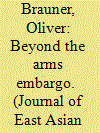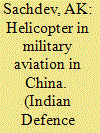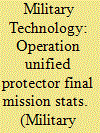| Srl | Item |
| 1 |
ID:
124770


|
|
|
|
|
| Publication |
2013.
|
| Summary/Abstract |
China has largely been cut off from direct transfers of military systems and technologies since the announcement of the EU arms embargo in 1989. Nevertheless, the EU and its member states remain a major source of high technologies for China, namely, by means of trade, investment, and scientific cooperation. This is mainly because the EU-China relationship continues to be dominated by the economic interests of individual member states, both in trade and increasingly in investments. Furthermore, due to a lack of direct security interests in the Asia-Pacific, Europeans do not generally see China as a security threat or a strategic competitor. Therefore, the EU has so far failed to develop a strategic approach toward the potential security implications of transfers of European militarily sensitive technologies that goes beyond the existing arms embargo and currently lacks effective mechanisms to control the flow of such technologies to China.
|
|
|
|
|
|
|
|
|
|
|
|
|
|
|
|
| 2 |
ID:
133056


|
|
|
|
|
| Publication |
2014.
|
| Summary/Abstract |
China has the world's second largest defence budget next only to the US and with the future looking upbeat tor China's economy and for its military spending, defense manufacturers and contractors the world over are eyeing the Chinese military helicopter market. Meanwhile, the types being produced as "indigenous" lag behind the leading edge of helicopter technology as extant in the Western world. It the US relents over the arms embargo, there could be a signilicant change in the tenor and texture of China's military helicopter fleet, with implications for a possible future Sino-Indian armed conflict.
|
|
|
|
|
|
|
|
|
|
|
|
|
|
|
|
| 3 |
ID:
122677


|
|
|
|
|
| Publication |
2012.
|
| Summary/Abstract |
NATO took control of all military operations for Libya under United Nations Security Council Resolutions 1970 & 1973 on 31 March 2011. Operation Unified Protector consisted of three elements: an arms embargo, a no-fly-zone and actions to protect civilians from attack or the threat of attack. This mission ended on 31 October 2011 at 23.59 local Libyan time.
|
|
|
|
|
|
|
|
|
|
|
|
|
|
|
|